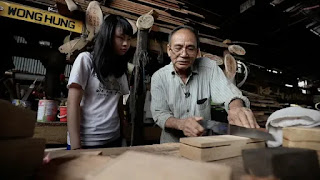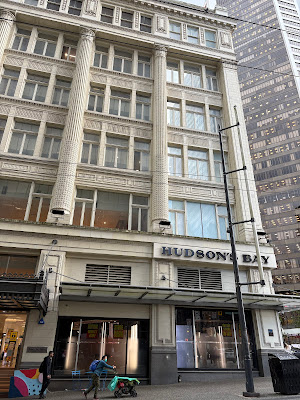 |
| The film documents Hong Kong's last sawmill |
This afternoon I went to see a Hong Kong documentary called
Fallen Treasures at Cinematheque this afternoon. Thinking there would be a lot of people, I arrived 40 minutes early to see that the organisers, HK House hadn't even set up yet.
I waited outside and slowly a line started to form behind me, but it turns out when we were finally allowed in minutes before the screening, that only about 30 people came, though this is Victoria Day weekend, a public holiday.
 |
| Wong is passionate about woodwork |
Directed by Elyse KY Hon, Fallen Treasures follows Wong Hung-kuen, the owner of Chi Kee Sawmill & Timber, the last sawmill in Hong Kong.
Hon had interviewed Wong in 2016 for a print story, but felt she could do a more comprehensive one on film. She began shooting in 2018 when he received an eviction notice because the government was going to develop the area into the Northern Metropolis, to connect Hong Kong with the mainland, and by extension into the Greater Bay Area.
The sawmill has old equipment, but continues to run well to remove the bark from tree trunks, and then slice them into planks. Wong patiently teaches young people how to make small chairs and stools, hoping that the next generation would be interested in woodworking.
He is so passionate about his work that everyday he wakes up at 6.30am and makes the two-hour commute from Siu Sai Wan to Sheung Shui. Wong works there with his younger sister, who cooks meals for the both of them and his employee who has been with the company for many years.
 |
| After the screening Hon talked to the audience |
But the deadline of moving Chi Kee is fast approaching and one might think Wong, in his 70s, would settle into retirement and close it, but this place is his reason for waking up everyday, and is focused on finishing commissions from clients than figuring out where to move the mill.
Wong is an endearing character, who is philosophical about life. Early on he says his son died at the age of 28 in 2010, and recalls the events that led to his passing. As the audience learns this piece of information, they become connected to him and understand why he wants to keep the sawmill going.
When he goes to a school to remove a tree that fell down during super typhoon Mangkut in 2018, he lights some sticks of incense to appease the spirits in the area. He can but also freely speaks his mind, saying the government claims it is concerned about the environment, but doesn't follow through.
For Hon, making Fallen Treasures was also a labour of love; she spent five years making the film on a shoestring budget. She recounted in an online Q&A session that the day of the deadline for Chi Kee to move was the last day the cinematographer helped her on the project and had to go back to their day job. So she had to continue filming it herself, as well as writing and editing.
 |
| Wong patiently taught young people on weekends |
The documentary is a profile about Wong, a record of Chi Kee's existence, and how the government handles evictions, and what it deems to be a cultural asset. Wong explains the sawmill uses only reclaimed wood and repurposes them into other useful items, which he believes is good for the environment. However, the government sees the sawmill as old, dated, and irrelevant.
Seeing Wong wanting to continue Chi Kee also gave her purpose and understanding why she was staying in Hong Kong, as she saw friends leave the city in the last few years. She feels it is important for her to stay and try to document things. When asked what she is working on now, Hon didn't specifically answer the question, but that she has found it's not easy to film things and comes across road blocks.
Nevertheless, she explained it was hard to get the film shown; she didn't have a distribution network and Hon went into bookshops in Sham Shui Po asking them to help distribute leaflets about the film, or host screenings. She and Wong attended the screenings, and many young people remembered Chi Kee in the news about its impending eviction.
We were lucky to see the film in Vancouver, and Hon was so happy that people across the Pacific saw her work.





















































